Dear IET forum,
I am carrying out research into the impacts of the projected surge of electric vehicle uptake on the local network infrastructure. The results will be used as part of my Technical report for Ceng. Please could you spare 2 minutes completing the survey in the link below? Its very short I assure you and completely anonymous. My aim is to understand a sample of peoples views on them personally taking up ownership of electric vehicles and if the pandemic may have changed their future car ownership behaviours.
When complete i can post the results here and if you are interested make a comment and i can send you the finished technical report.
Much appreciated, thank you in advance.!
https://www.surveymonkey.co.uk/r/CC7GJSB


